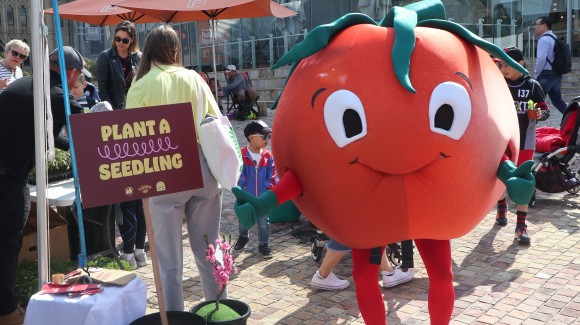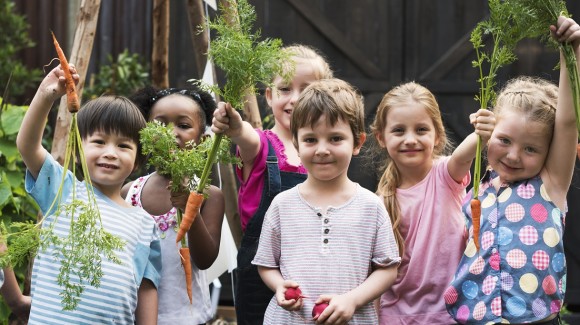
Kids
Vegetable hacks for kids
Is your dining room floor often littered with broccoli after your toddler has eaten? Or does your child's lunchbox come home with the vegetables untouched? Vegetables are often among the least favorite foods, especially for young children. This can be frustrating because, as a parent, you know how important it is for your children to eat healthily.
Vegetables are an essential part of a healthy diet. However, research shows that Dutch children generally eat too few vegetables. According to the CBS, only 4 out of 10 children meet the recommended daily intake of vegetables. The figures vary significantly between age groups: young children aged 1 to 4 years, who need 50-100 grams per day, are more likely to eat enough vegetables (59%) than older children aged 9 to 12 years, who need 150-200 grams per day. Of these older children, only 25% meet the recommended amount.
Children reject vegetables for various reasons, such as:
- Bitter flavors: The bitter taste often forms the biggest obstacle to why children refuse vegetables. In nature, bitterness can signal potential toxicity, and this ancient defense mechanism is still active in children. Additionally, their taste buds are more sensitive, making them experience bitterness more intensely than adults.
- Unpleasant texture: The texture of vegetables, such as the crunchiness of raw carrots, the fibrousness of asparagus, or the softness of cooked spinach, can be off-putting for children.
- Low energy value: Vegetables contain fewer calories, which can be less satisfying for children.
- Neophobia: Many children are naturally hesitant or anxious to try new or unfamiliar foods. This is known as food neophobia and can make children less inclined to try vegetables.
So, children naturally don't like vegetables. How can you encourage them to eat more?
Vegetable Hacks: How to make vegetables more appealing to your children
Eating habits developed in childhood often persist into adulthood. Developing vegetable habits in children can help reduce the risk of chronic diseases later in life. By exposing children to vegetables from an early age and creating positive associations, you can contribute to healthy eating habits that last a lifetime.
Repeated exposure
Offering vegetables repeatedly can help children develop an appreciation for them. Research shows that children are more likely to appreciate a new taste the more they are exposed to it. This can also help reduce food neophobia. It may take 10 or more attempts before your child accepts a new vegetable. So, be patient, keep it fun and positive, and continue offering the vegetable, even if it was previously rejected. Let children look at, touch, and smell vegetables. This can be a fun and lighthearted way to introduce them. One broccoli floret or a slice of carrot on the plate is enough.
However, repeated exposure means more than just offering vegetables. You can also think about:
- Sparking curiosity:
Make children excited about vegetables and spark their curiosity by letting them try different types of vegetables early and often, both raw and cooked. Organize a "tasting" session with carrots, cherry tomatoes, cucumber, bell peppers, broccoli, and cauliflower. Let them try different preparations, such as roasting, steaming, or mashing. Make it a fun game by cutting vegetables into interesting shapes like stars, flowers, or spirals, having them taste blindfolded, or letting your children find their favorite combination of flavors and textures.
- Reading stories about vegetables:
Read stories about vegetables to make children curious and create a positive association with vegetables. Look for children's books that focus on vegetables, such as adventures of vegetable heroes like Freddie Broccoli, a musical rebel with a golden heart from "Brock 'n Roll." Other examples of children's books featuring vegetables include "World Eaters," "Chameleon Doesn't Like Color," and "Taste Ghosts." During cooking and eating, you can tell stories about where the vegetables come from and how they grow, which can stimulate your children's imagination and help them eat more vegetables.
- Setting a good example:
Show your children that vegetables are delicious by eating them yourself in their presence. Children often mimic their parents' behavior. If they see you enjoying vegetables, they are more likely to try them themselves. Make it a habit to eat together as a family and always serve vegetables with meals. Involve your children in choosing vegetables at the supermarket or market.
- Growing vegetables in your own garden or balcony:
Growing vegetables together can be a fun and educational activity that makes them curious about eating vegetables they have helped grow. Start with easy-to-grow vegetables like radishes, carrots, or cherry tomatoes. Let your children be responsible for watering and caring for the plants. This gives them a sense of pride and ownership over the vegetables. When it's time to harvest, involve them in preparing the freshly picked vegetables for a meal. Washing and preparing the vegetables together gives them a sense of involvement and makes eating them less intimidating.
Although children may not be excited about vegetables at first, this does not mean they will always reject them. By introducing and exploring vegetables in a fun and playful way, children will be more likely to accept them. With a combination of creativity, repeated exposure, and patience, you can help children develop a lasting love for vegetables. This will not only improve their eating habits but also contribute to a healthier lifestyle in the long term.
References
- Ahern SM et al. Eating a rainbow. Introducing vegetables in the first years of life in 3 European countries. Appetite. 2013;71(0):48-56.
- Barends C et al. A systematic review of practices to promote vegetable acceptance in the first three years of life. Appetite. 2019;137:174-197.
- Bell LK et al. Supporting strategies for enhancing vegetable liking in the early years of life: an umbrella review of systematic reviews. Am J Clin Nutr. 2021;113(5):1282-1300.
- Bere E et al. Changes in accessibility and preferences predict children's future fruit and vegetable intake. Int J Behav Nutr Phys Act. 2005;2(1):15-22.
- Blanchette L et al. Determinants of fruit and vegetable consumption among 6-12-year-old children and effective interventions to increase consumption. Br Diet Assoc. 2005;18:431-443.
- Brug J et al. Taste preferences, liking and other factors related to fruit and vegetable intakes among schoolchildren: results from observational studies. Br J Nutr. 2008;99(S1)
- Caton SJ et al. Learning to eat vegetables in early life: the role of timing, age and individual eating traits. PLoS One. 2014;9(5)
- CBS. Children eat too little fruit, vegetables, and fish [Internet]. 2017 [cited 2024 May 29]. Available from: https://www.cbs.nl/nl-nl/nieuws/2017/46/kinderen-eten-te-weinig-fruit-groente-en-vis.
- Cooke LJ et al. Facilitating or undermining? The effect of reward on food acceptance: a narrative review. Appetite. 2011;57(2):493-497.
- De Cosmi V et al. Early taste experiences and later food choices. Nutrients. 2017;9(2):107.
- Gibson EL et al. Energy density predicts preferences for fruit and vegetables in 4-year-old children. Appetite. 2003;41(1):97-98.
- Wadhera D et al. Perceived recollection of frequent exposure to foods in childhood is associated with adulthood liking. Appetite. 2015;89(1):22-32.
- Zeinstra GG et al. Cognitive development and children's perceptions of fruit and vegetables: a qualitative study. Int J Behav Nutr Phys Act. 2007;4:30-40




